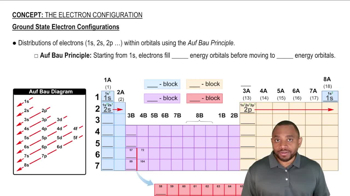Consider the Mg2+, Cl-, K+, and Se2- ions. The four spheres below represent these four ions, scaled according to ionic size. (b) In terms of size, between which of the spheres would you find the (i) Ca2+ and (ii) S2- ions?
Group 1A and 2A elements are sometimes called, collectively, “the s-block.” Therefore, what is an analogous name for the entire collection of the group 3A, 4A, 5A, 6A, 7A, and 8A elements?
 Verified step by step guidance
Verified step by step guidance
Verified video answer for a similar problem:
Key Concepts
Periodic Table Groups

p-block Elements

Block Designation in the Periodic Table

In the following reaction
which sphere represents a metal and which represents a nonmetal?
The graph below shows the ionization energies for a particular element. In which group is the element most likely a member of? [Section 7.3]
The prefix eka- comes from the Sanskrit word for 'one.' Mendeleev used this prefix to indicate that the unknown element was one place away from the known element that followed the prefix. For example, eka-silicon, which we now call germanium, is one element below silicon. Mendeleev also predicted the existence of eka-manganese, which was not experimentally confirmed until 1937 because this element is radioactive and does not occur in nature. Based on the periodic table shown in Figure 7.1, what do we now call the element Mendeleev called eka-manganese?
Among elements 1–18, which element or elements have the smallest effective nuclear charge if we use Equation 7.1 to calculate 𝑍eff? Which element or elements have the largest effective nuclear charge?
